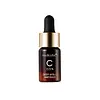What's inside
What's inside
 Key Ingredients
Key Ingredients

 Benefits
Benefits

 Concerns
Concerns

 Ingredients Side-by-side
Ingredients Side-by-side

Water
Skin ConditioningTetrahexyldecyl Ascorbate
AntioxidantC13-15 Alkane
SolventCocoglycerides
EmollientHelianthus Annuus Seed Wax
Skin ConditioningAcrylates Crosspolymer
AbsorbentButylene Glycol
HumectantPolyhydroxystearic Acid
EmulsifyingDiisostearyl Malate
EmollientPolyglyceryl-4 Oleate
EmulsifyingCetearyl Olivate
Alpha-Arbutin
AntioxidantCitric Acid
BufferingFerulic Acid
AntimicrobialSodium PCA
HumectantTocopherol
AntioxidantMalic Acid
BufferingGluconolactone
Skin ConditioningPolyglyceryl-6 Oleate
EmulsifyingSorbitan Olivate
EmulsifyingBis-Behenyl/Isostearyl/Phytosteryl Dimer Dilinoleyl Dimer Dilinoleate
EmollientSodium Benzoate
MaskingCalcium Gluconate
HumectantWater, Tetrahexyldecyl Ascorbate, C13-15 Alkane, Cocoglycerides, Helianthus Annuus Seed Wax, Acrylates Crosspolymer, Butylene Glycol, Polyhydroxystearic Acid, Diisostearyl Malate, Polyglyceryl-4 Oleate, Cetearyl Olivate, Alpha-Arbutin, Citric Acid, Ferulic Acid, Sodium PCA, Tocopherol, Malic Acid, Gluconolactone, Polyglyceryl-6 Oleate, Sorbitan Olivate, Bis-Behenyl/Isostearyl/Phytosteryl Dimer Dilinoleyl Dimer Dilinoleate, Sodium Benzoate, Calcium Gluconate
Water
Skin ConditioningAscorbic Acid
AntioxidantButylene Glycol
HumectantDipropylene Glycol
HumectantPropanediol
SolventDicaprylyl Carbonate
EmollientPropylene Glycol Dicaprylate
EmollientIsopropyl Oleate
EmollientIsopropyl Sorbate
AntimicrobialPolysorbate 60
EmulsifyingGlutathione
Glycerin
HumectantAlpha-Ionol
PerfumingGlyceryl Stearate
EmollientPanthenol
Skin ConditioningCitric Acid
BufferingChitosan
Pullulan
Sodium Gluconate
Skin ConditioningSodium Hyaluronate
HumectantHelianthus Annuus Seed Oil
EmollientDimethicone
EmollientEthylhexyl Methoxycinnamate
UV AbsorberCetrimonium Chloride
AntimicrobialSodium Chloride
MaskingVigna Radiata Seed Extract
Skin ConditioningHydrolyzed Grape Fruit Extract
HumectantEclipta Prostrata Extract
Skin ConditioningGlycine Soja Seed Extract
Skin ConditioningBeta-Carotene
Skin ConditioningDaucus Carota Sativa Seed Oil
EmollientCurcuma Longa Root Extract
MaskingTerminalia Ferdinandiana Fruit Extract
AntioxidantBeta-Glucan
Skin ConditioningBetula Alba Bark Extract
MaskingUlmus Davidiana Root Extract
Skin ConditioningSodium Alum
AstringentWater, Ascorbic Acid, Butylene Glycol, Dipropylene Glycol, Propanediol, Dicaprylyl Carbonate, Propylene Glycol Dicaprylate, Isopropyl Oleate, Isopropyl Sorbate, Polysorbate 60, Glutathione, Glycerin, Alpha-Ionol, Glyceryl Stearate, Panthenol, Citric Acid, Chitosan, Pullulan, Sodium Gluconate, Sodium Hyaluronate, Helianthus Annuus Seed Oil, Dimethicone, Ethylhexyl Methoxycinnamate, Cetrimonium Chloride, Sodium Chloride, Vigna Radiata Seed Extract, Hydrolyzed Grape Fruit Extract, Eclipta Prostrata Extract, Glycine Soja Seed Extract, Beta-Carotene, Daucus Carota Sativa Seed Oil, Curcuma Longa Root Extract, Terminalia Ferdinandiana Fruit Extract, Beta-Glucan, Betula Alba Bark Extract, Ulmus Davidiana Root Extract, Sodium Alum
Ingredients Explained
These ingredients are found in both products.
Ingredients higher up in an ingredient list are typically present in a larger amount.
Butylene Glycol (or BG) is used within cosmetic products for a few different reasons:
Overall, Butylene Glycol is a safe and well-rounded ingredient that works well with other ingredients.
Though this ingredient works well with most skin types, some people with sensitive skin may experience a reaction such as allergic rashes, closed comedones, or itchiness.
Learn more about Butylene GlycolCitric Acid is an alpha hydroxy acid (AHA) naturally found in citrus fruits like oranges, lemons, and limes.
Like other AHAs, citric acid can exfoliate skin by breaking down the bonds that hold dead skin cells together. This helps reveal smoother and brighter skin underneath.
However, this exfoliating effect only happens at high concentrations (20%) which can be hard to find in cosmetic products.
Due to this, citric acid is usually included in small amounts as a pH adjuster. This helps keep products slightly more acidic and compatible with skin's natural pH.
In skincare formulas, citric acid can:
While it can provide some skin benefits, research shows lactic acid and glycolic acid are generally more effective and less irritating exfoliants.
Most citric acid used in skincare today is made by fermenting sugars (usually from molasses). This synthetic version is identical to the natural citrus form but easier to stabilize and use in formulations.
Read more about some other popular AHA's here:
Learn more about Citric AcidWater. It's the most common cosmetic ingredient of all. You'll usually see it at the top of ingredient lists, meaning that it makes up the largest part of the product.
So why is it so popular? Water most often acts as a solvent - this means that it helps dissolve other ingredients into the formulation.
You'll also recognize water as that liquid we all need to stay alive. If you see this, drink a glass of water. Stay hydrated!
Learn more about Water